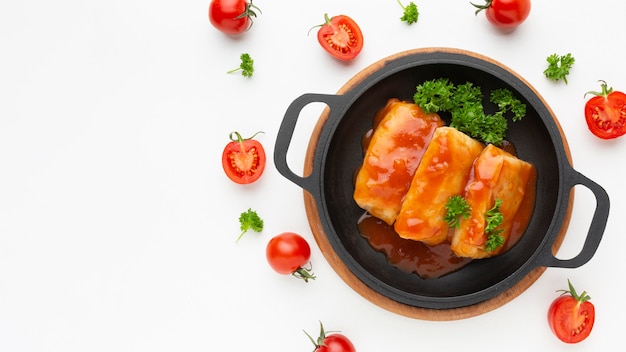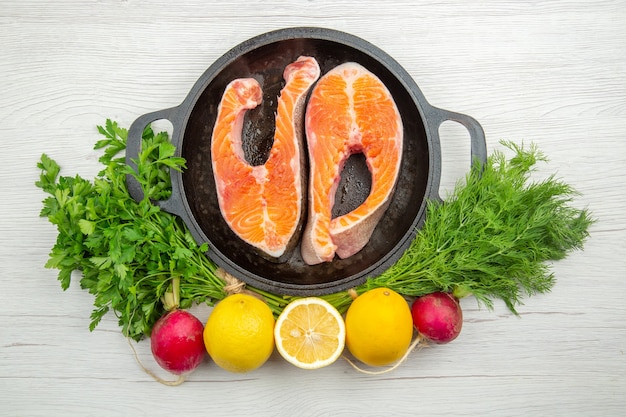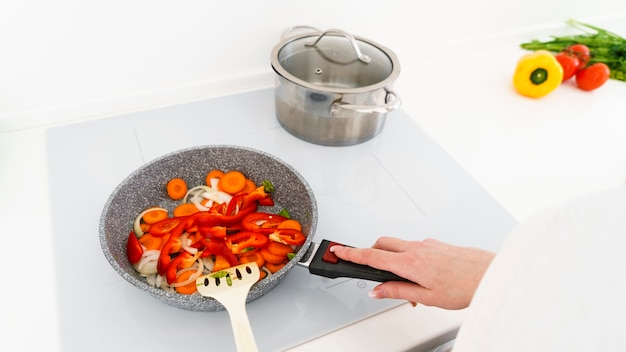Let's talk salmon, shall we? It’s a true culinary gem, isn’t it? This fish is incredibly versatile, healthy, and when cooked right, it simply melts in your mouth. But, we’ve all been there, haven’t we? That dreadful moment when you bite into a dry, overcooked salmon fillet, a real culinary tragedy. Over the years, I’ve experimented with countless pan-searing techniques, and I’m finally ready to share my secret recipe for perfectly cooked salmon. And trust me, it’s much simpler than you think. Grab a notepad and get ready to take notes because we’re about to dive deep into the wonderful world of pan-seared salmon.
(Part 1) Choosing Your Salmon: The Foundation of Success

The journey to a perfect pan-seared salmon begins with selecting the right fish. Now, I’m a firm believer in supporting sustainable fishing practices, so I always look for labels like MSC (Marine Stewardship Council). It makes a real difference, you know?
Skin-On or Skin-Off? The Great Debate
You’ll often find salmon fillets with skin on or skin off. I personally prefer skin-on fillets because the skin acts as a protective barrier for the delicate flesh, ensuring even cooking. It also adds a beautiful crispy texture to the dish, a real bonus for me. However, if you’re not a fan of the skin, skin-off fillets work just as well.
Fresh vs. Frozen: A Matter of Preference
Fresh salmon is undoubtedly a culinary delight, but if you can't find it, frozen salmon can be equally delicious. Just make sure it's properly frozen and thawed before cooking. And remember, never refreeze thawed salmon!
Thickness is King: A Key to Even Cooking
When choosing your salmon, I recommend opting for fillets that are around 1 inch thick. This ensures that the fish cooks evenly without becoming dry. If you find thinner fillets, don't worry, you can simply reduce the cooking time accordingly.
(Part 2) Preparing Your Salmon: Setting the Stage for Success

Pat it Dry: A Simple Step with Big Impact
Once you’ve got your salmon, pat it dry with some kitchen paper. This is crucial because excess moisture will make the skin stick to the pan and hinder proper browning.
Salt and Pepper: The Foundation of Flavor
Now, for the seasoning. I always start with a generous pinch of salt and freshly ground black pepper. Don't be shy! You can always add more later, but you can't take it away once it's on.
Spice Things Up: Exploring flavor profiles
While salt and pepper are the basics, feel free to get creative with your seasoning! I love adding a pinch of smoked paprika for a smoky flavour, or some freshly chopped herbs like dill or parsley.
Lemon Zest: A Bright and Refreshing Touch
A touch of lemon zest is a game-changer for salmon. It adds a wonderful citrusy aroma and a delightful zest to the dish.
(Part 3) Pan-Searing Secrets: Mastering the Art of Heat

The Right Pan: Choosing Your Culinary Weapon
A good pan is essential for perfect pan-searing. You want to choose a heavy-bottomed pan that distributes heat evenly. I personally use a cast iron skillet, but a stainless steel pan will work just as well.
Get It Hot: The Importance of High Heat
Heat your pan over medium-high heat. You want the pan to be hot enough to sear the salmon quickly and create a beautiful crust. You can test the heat by placing a drop of water on the pan – if it sizzles and evaporates immediately, you're good to go.
Oil It Up: The Lubricant for Perfect Browning
Once your pan is hot, add a tablespoon or two of your preferred cooking oil. I usually use olive oil, but avocado oil or grapeseed oil work well too.
Don't Crowd the Pan: Giving Salmon Space to Breathe
Don’t be tempted to overcrowd your pan. The salmon needs space to cook properly. If you have multiple fillets, cook them in batches to avoid overcrowding.
The Skin-Side First: Achieving a Crispy Crust
Place the salmon fillets in the pan, skin-side down. Let them cook undisturbed for about 3-4 minutes. You want the skin to become crispy and golden brown.
Flip It Over: Gently and with Care
After about 3-4 minutes, carefully flip the salmon fillets over. Use a thin spatula to make sure the skin doesn’t stick to the pan.
Reduce the Heat: Finishing with a Gentle Touch
Once you’ve flipped the salmon, reduce the heat to medium-low and continue cooking for another 2-3 minutes. The internal temperature of the salmon should reach 145°F (63°C).
Check for Doneness: Ensuring a Perfect Finish
To test for doneness, use a sharp knife to insert into the thickest part of the salmon. The flesh should be opaque and flake easily. If it’s still translucent, it needs more time to cook.
(Part 4) Serving Your Salmon: The Art of Presentation
Resting Time: Allowing Juices to Redistribute
Once your salmon is cooked, remove it from the pan and let it rest for a few minutes before serving. This allows the juices to redistribute throughout the fish, ensuring a moist and tender result.
The Garnish: Adding Visual Appeal and Flavor
Now, it’s time to get creative with your garnish. There are endless possibilities! A squeeze of lemon juice, a sprinkle of fresh herbs, a drizzle of olive oil, or a dollop of creamy sauce – the choice is yours!
side dishes: Complements to a Stellar Salmon
Pan-seared salmon goes perfectly with a variety of side dishes. I love serving it with roasted vegetables like asparagus, broccoli, or Brussels sprouts. A side of quinoa or brown rice is another great option.
(Part 5) Common Mistakes to Avoid: Avoiding Culinary Disasters
Here’s a little cheat sheet on some common mistakes people make when pan-searing salmon, and how to avoid them:
Overcrowding the Pan: A Recipe for Uneven Cooking
Overcrowding the pan will lead to steam build-up and prevent the salmon from browning properly. Always cook in batches if you have more than one fillet.
Not Letting the Pan Get Hot Enough: Crucial for Browning
If the pan isn’t hot enough, the salmon won’t sear properly. Make sure it’s piping hot before adding the fish.
Flipping the Salmon Too Soon: Patience is Key
Don’t be tempted to flip the salmon too soon. Let the skin side cook for at least 3-4 minutes to create a crispy crust.
Cooking the Salmon for Too Long: Dryness is the Enemy
Overcooking salmon will result in dry, flaky fish. Use a meat thermometer to ensure it’s cooked through but still juicy.
Not Letting the Salmon Rest: A Simple Step with Big Impact
Allowing the salmon to rest before serving helps to redistribute the juices, resulting in a more flavorful and tender fish.
(Part 6) Creative Variations: Exploring Flavor Frontiers
Now that you’ve mastered the basics, let's get creative! Here are a few ideas to take your pan-seared salmon to the next level:
Citrusy Salmon: A Burst of Freshness
Add a burst of citrusy flavor with lemon, lime, or orange zest. You can also use citrus juice for a tangy sauce.
Garlic and Herb Salmon: A Classic with a Twist
Combine garlic, fresh herbs like dill, parsley, or thyme, and a pinch of salt and pepper for a classic and aromatic flavor.
smoked salmon with Honey Glaze: Sweet and Savory Bliss
Combine smoked salmon with a sweet and savory honey glaze for a truly decadent dish.
Sesame and Ginger Salmon: A Flavorful Asian-Inspired Creation
Mix sesame seeds, grated ginger, and soy sauce for a flavorful Asian-inspired salmon.
Spicy Salmon: A Touch of Heat for Adventure
Add a kick of spice with chili flakes, cayenne pepper, or jalapeno peppers.
(Part 7) The Ultimate Guide: A Table of Contents for Quick Reference
Here's a quick overview of everything we've covered so far:
| Part | Content |
|---|---|
| Part 1 | Choosing Your Salmon |
| Part 2 | Preparing Your Salmon |
| Part 3 | Pan-Searing Secrets |
| Part 4 | Serving Your Salmon |
| Part 5 | Common Mistakes to Avoid |
| Part 6 | Creative Variations |
(Part 8) FAQs: Addressing Your Burning Questions
Here are some frequently asked questions about pan-searing salmon:
1. What's the best way to thaw frozen salmon?
The safest way to thaw frozen salmon is in the refrigerator. Place the salmon on a plate and allow it to thaw for 24 hours. You can also thaw it in cold water, but make sure the water is constantly running to prevent bacterial growth.
2. How long does it take to pan-sear salmon?
The cooking time for pan-seared salmon depends on the thickness of the fillet. A 1-inch thick fillet will typically take about 5-7 minutes to cook.
3. Can I pan-sear salmon with the skin on?
Yes, you can pan-sear salmon with the skin on. In fact, it’s a great way to create a crispy texture and prevent the fish from sticking to the pan.
4. How do I know when the salmon is cooked?
The best way to check for doneness is to use a meat thermometer. The internal temperature should reach 145°F (63°C). You can also test for doneness by gently pressing the flesh with a fork. If it flakes easily, it's cooked.
5. What are some good side dishes to serve with pan-seared salmon?
Pan-seared salmon pairs well with a variety of side dishes. Roasted vegetables, quinoa, brown rice, and salads are all excellent options.
(Part 9) Final Thoughts: Embracing the culinary journey
And there you have it, folks! Everything you need to know about pan-searing salmon. I hope you found this guide helpful. So, next time you’re craving a delicious and healthy meal, give pan-seared salmon a try. It’s a simple yet impressive dish that’s sure to impress your family and friends. Happy cooking!
Everyone is watching

Corn on the Cob: The Ultimate Guide to Perfectly Cooked Ears
Healthy MealsAh, corn on the cob. Just the name evokes images of sunny days, barbecues, and that sweet, juicy flavour that ...

Perfect Pork Roast Oven Cooking Time: A Guide to Delicious Results
Healthy MealsThere's something truly satisfying about a perfectly roasted pork. The aroma alone is enough to make your mout...

Ham Cooking Time: How Long to Bake, Smoke, or Boil a Delicious Ham
Healthy MealsAh, ham. It's a classic, isn't it? A real crowd-pleaser, especially around holidays. And when done right, it'...

Scallops: The Ultimate Guide to Perfect Cooking
Healthy MealsAh, scallops. Those delicate, sweet, and utterly delicious morsels of the sea. They hold a special place in my...

Spaghetti Squash: The Ultimate Guide to Cooking and Serving
Healthy MealsRemember that time you saw spaghetti squash at the supermarket, looking all bumpy and strange, and thought, "W...
